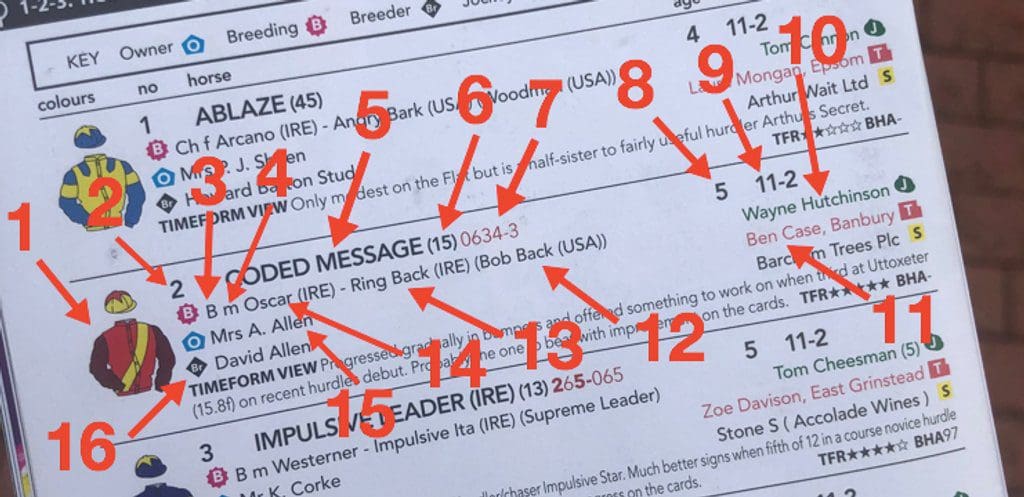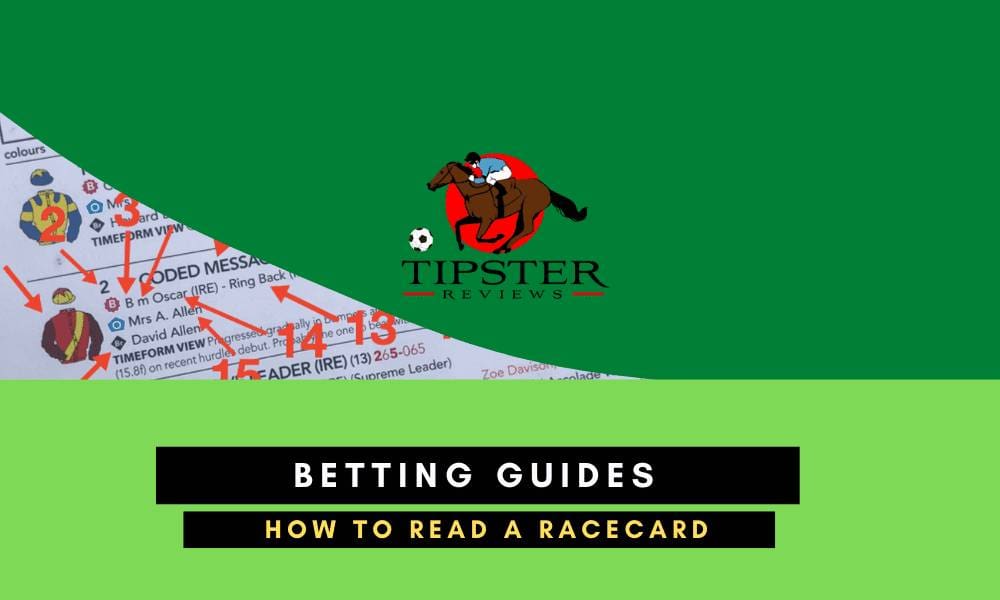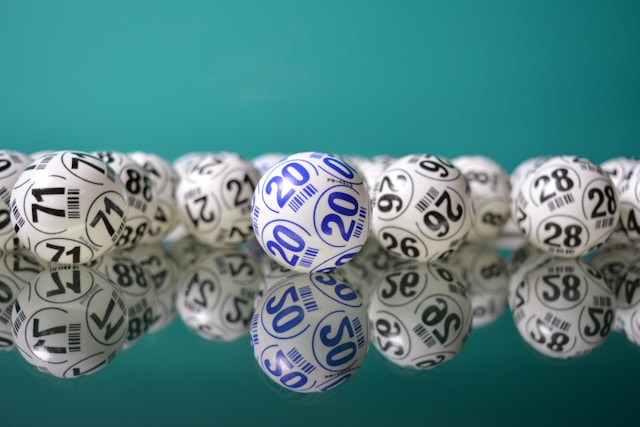Over the years I have certainly gotten to know how to read a racecard properly but I do remember when I got my first look at one it was very confusing trying to read the form accurately.
You will always get someone who thinks they know it all about a horse racing racecard, so take this article as a chance to correct them and show them you’re the know it all now.
There are many things to look at on the race card so below is an example of a race card, each section is numbered off and I will reveal what each means for you.

Reading A Racecard Is Easy When You Know How
From the image above here are what each number means for you in as simple form as possible so it’s easy to understand from a complete newbie to a seasoned pro who doesn’t know the odd one how to read a racecard in full.
- 1) Jockey Colours (Silks) – This is the jockey’s colours you should be looking for during the race, it’s a unique combination to any other horse in the race and though sometimes some jockeys will have similar colours there is always a slight difference for everyone. On occasions, if there are two or more jockeys with the same colours they are from the same stable and so you should go by any slight difference such as the cap colour to tell yours apart or by the number.
- 2) This is your horse’s number, usually in order from 1-10 (if there were 10 horses for example) but many online racecards like Attheraces list horses in order of their odds. This number is shown on the horse’s side.
- 3) This is the horse’s colour on this example B stands for bay. Below is a list of the other colours and the abbreviations for them you may see here on a race card. This is another good way of telling your horse apart should the jockey colours be very similar to another.
b – bay
bl – black
br – brown
ch – chestnut
gr – grey
r – rig
ro – roan
wh – white
- 4) This is the horse’s sex, in the above example its a mare but below are other examples
c – colt: this is a male horse under four
f – filly: a female horse under four
g – gelding: a castrated male horse
h – horse: a male horse above four
m – mare: a female horse above four
- 5) This is the horse’s name and is probably the easiest bit to understand.
- 6) In brackets, this is the number of days since this horse last ran and anything above 90 days may suggest that this horse has had a break from training and may need the run.
- 7) In my opinion one of the most overlooked yet important things on a race card, this is how the horse performed in its last 6 outings. In the above example, the horse finished outside the top 10 – with a 0, before finishing sixth, third, fourth, and most recently third.
A – between the numbers indicate a different year separation, (i.e. left of this is from a previous year)
A / between the numbers indicates a change of season (i.e. left of this is from the season before last)
Other letters that will appear here may indicate some unfortunate incidents in this horse’s previous races, this can be very informative to know going forward and here are the ones you need to know about:
B – brought down
C – carried out
D – disqualified
F – fell
HR – hit rails
L – left at start
O – horse ran out
P – pulled up
R – refused
S – slipped up
U – unseated rider
V – void race
- 8) This is the horse’s current age, this can be useful to know if the race is not restricted to certain age groups as you may have very old horses racing against younger ones.
- 9) The horse’s weight and this includes the jockey’s weight too, this is very important when the race is a handicap as some horses will carry more weight due to their abilities compared to other lesser horses who carry less weight thus evening the playing field
- 10) This is the name of the jockey aboard, some punters follow jockeys in form or jockeys that have gone on winning runs like Frankie Dettori when he had his magnificent 7 winners.
- 11) The trainer’s name, again something that many punters follow but its nothing to fall in love with too much from my experience.
- 12) The Sire (father) of the horse’s Dam (mother). Some Dam’s are never raced, so the dam’s sire may give you a better look into the horses pedigree and potential, for example, Frankel or Sea The Stars as a sire would be a plus.
- 13) The dam or mother of the horse.
- 14) This is the sire or father of the horse.
- 15) This is the owner or owners, the person who owns the horse sometimes this could be a syndicate or a sole individual. Godolphin for example would be from a famous yard and owner who has multiple horses.
- 16) This is the breeder of the horse, some people also follow certain breeders when making their selections.
How To Read A Racecard – Other things to look for when reading a racecard properly
h – hood
b – blinkers
cp – cheekpieces
t – tongue-tie
v – visor
e – eye hood
e/c – eyecover
e/s – eyeshield
- Although missing on this race card, many cards feature extra letters near the form figures. This can go further in-depth to a horse’s history:
BF – beaten favourite last time out
C – previous course winner
CD – previous course and distance winner
D – previous distance winner
Below is an informative video that explains all the above in a bit more detail for you on how to read a racecard properly, this is just in case there’s something you are unsure of (or if your too lazy to read the above lol)
So there you have it now you should be able to school your friends and family on how to read a racecard properly for horse racing, I expect you all to be backing a few more winners now with this knowledge under your hats.
Don’t forget to check out our other betting guides that will help you take your betting to the next level/
That being said I would always recommend using one of the horse racing tipsters as the best approach to long-term success so don’t forget to check out all the reviews I have posted for you all.



